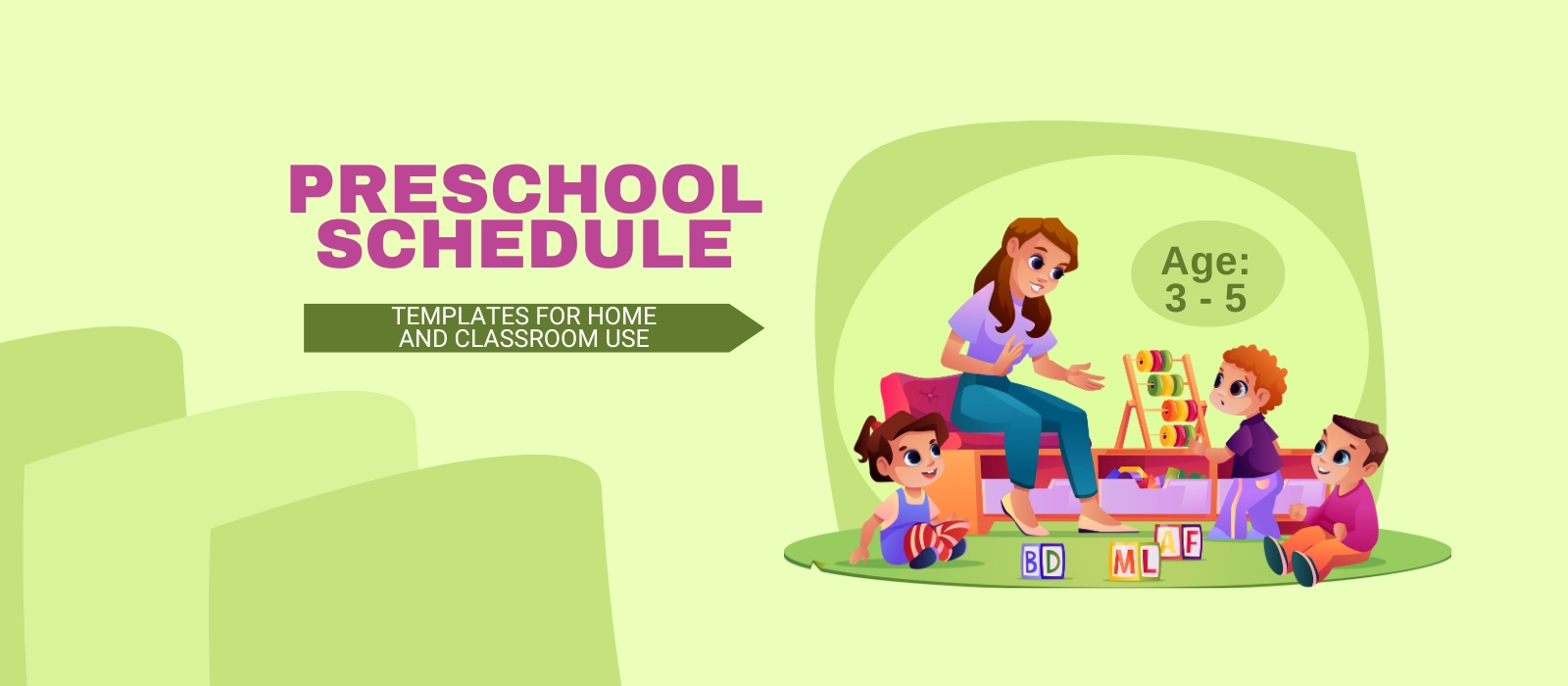Are you constantly wondering how to create a preschool schedule that actually works? Do you feel overwhelmed by the chaos of free play, nap time, and snack breaks that seem to happen at random? Are you unsure how long each activity should last or how to structure learning vs play?
A sample preschool schedule offers the perfect solution to bring structure, flow, and confidence to your preschool day—whether at home or in a classroom. A well-designed preschool schedule is more than just time blocks; it’s a developmental roadmap that supports emotional regulation, attention spans, and learning outcomes.
If you’re looking for clarity, organization, and results in your early childhood setup—keep reading. This is your complete guide to crafting and customizing the perfect preschool schedule.
Why a Preschool Schedule Matters
A consistent preschool schedule is more than just a clock-based structure—it’s a vital support system for young children. Preschoolers thrive on routine. A well-organized daily flow helps them feel safe, secure, and confident in their environment. When children know what comes next, they’re less anxious and more cooperative.
For educators and parents alike, a daily preschool schedule provides direction and structure. It allows us to prepare materials, manage transitions, and balance learning with play. From group activities to independent exploration, everything fits better into a predictable rhythm.
Studies in early childhood education show that consistent schedules help children develop executive function skills, including time management, emotional control, and task persistence.
For example, when circle time always follows arrival, and outdoor play consistently comes after snack time, children begin to internalize that rhythm. This boosts their sense of autonomy—because they know what to expect and how to respond.
On a practical level, a strong preschool day schedule can reduce tantrums and transitional resistance. That’s because children are mentally and emotionally prepared for the shift. This is especially critical in classrooms where managing group behavior efficiently can directly impact learning outcomes.
Whether you’re using a preschool schedule at home or in a professional setting, it sets the tone for productivity, calm, and growth. And when you implement a visual schedule or picture chart, it becomes even more accessible to non-readers and neurodiverse learners.
So before diving into printable templates and visual charts, it’s crucial to first understand the ‘why’ behind scheduling. The goal isn’t just to fill time—it’s to give children the framework they need to thrive.
Preschool Daily Schedule Templates (With Free Printables)
Why Use a Template for Your Preschool Schedule?
Preschool schedule templates save you time and ensure you’re not missing essential developmental areas. They help structure your day without having to reinvent the wheel. With a sample preschool schedule template, both new and experienced educators can find balance between structured activities and flexible play.
Templates also make collaboration easier. If you’re a preschool director, you can share editable documents with staff. If you’re a parent, printable versions can be posted on the fridge to keep everyone in sync. Plus, they serve as an excellent starting point for customizing based on your unique group of children.
Types of Preschool Schedule Printables You Can Use
There are different types of printable preschool schedule resources available:
- Editable PDFs: Great for customizing your own class times
- Visual charts with icons: Ideal for non-readers
- Picture cards: Can be moved around for flexibility in routine
- Magnet board schedules: Hands-on interaction for kids
You can find several high-quality free editable preschool schedule printable online. Check out this free resource to start designing your own.
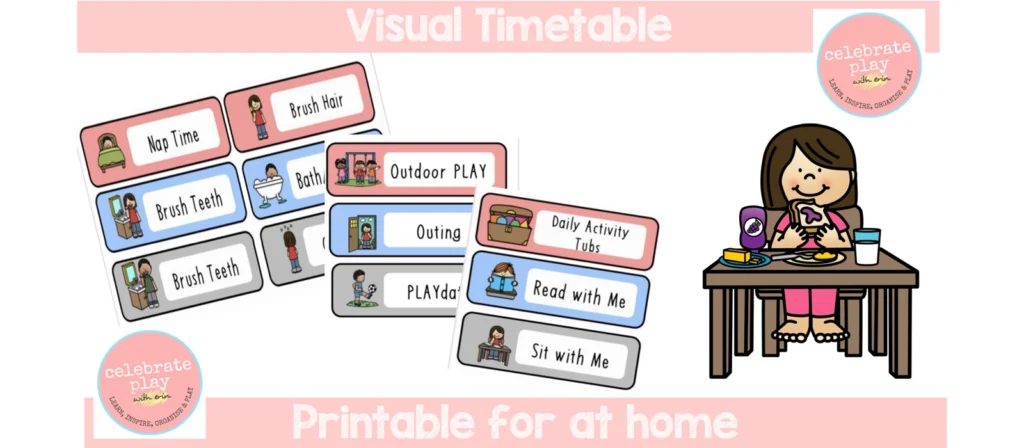
How to Customize a Sample Preschool Schedule for Your Needs
No two preschools (or homes) are alike. That’s why a sample preschool schedule should be adapted to your environment:
- At Home: Include more unstructured time and family-centered activities
- In Classrooms: Stick to clear start/end times, and include centers, circle time, outdoor play
- Montessori or Play-Based Settings: Focus on work cycles and open-ended tasks
Adjust your preschool schedule based on your daily rhythm, children’s attention spans, and seasonal transitions. You can also experiment with full day or half day models to see what fits best.
In the next section, we’ll break these down by age to help you fine-tune your approach even more effectively.
Daily Preschool Schedule by Age Group
Daily Schedule for 3-Year-Old Preschoolers
At age 3, children are still building foundational social and self-regulation skills. A preschool schedule for 3-year-olds should include lots of transition time, sensory play, and simplified tasks.
Here’s a typical sample:
- 8:30 AM – Arrival & Free Play
- 9:00 AM – Morning Circle (songs, calendar, weather)
- 9:30 AM – Sensory Play or Learning Centers
- 10:15 AM – Snack Time
- 10:30 AM – Outdoor Recess
- 11:15 AM – Story Time
- 11:45 AM – Lunch
- 12:15 PM – Nap/Quiet Time
- 2:00 PM – Fine Motor or Art Activities
- 2:30 PM – Music & Movement
- 3:00 PM – Dismissal or Free Play
You can adjust the time blocks depending on whether you operate a full-day or half-day preschool. Visual schedules work very well for this age group.
Daily Schedule for 4-Year-Old Preschoolers
Four-year-olds have longer attention spans and stronger motor skills, which allows for slightly more academic activities and structured group learning. Still, a good preschool schedule should balance this with creativity and movement.
Example routine:
- 8:30 AM – Arrival & Table Activities (puzzles, writing)
- 9:00 AM – Circle Time & Calendar
- 9:30 AM – Learning Centers (STEM, dramatic play, literacy)
- 10:15 AM – Snack
- 10:30 AM – Outdoor Play
- 11:15 AM – Group Project or Science Time
- 11:45 AM – Lunch
- 12:15 PM – Rest or Quiet Reading
- 1:30 PM – Art & Creativity Block
- 2:15 PM – Music, Yoga, or Language Exploration
- 3:00 PM – Goodbye Circle
Preschool schedules for 4-year-olds can incorporate more rotations and prep for kindergarten readiness. Remember to leave enough time for transitions and clean-up.
Adjusting Based on Maturity, Not Just Age
Not all 3- or 4-year-olds follow the same developmental path. Some 3.5-year-olds may fit better in a 4-year-old schedule, while others still need extra downtime. The best preschool schedule examples are always flexible and responsive to children’s individual needs.
Use a preschool daily schedule template to test different timing blocks. Monitor energy levels and behavior to tweak the flow accordingly.
Coming up next: how to build effective at-home or homeschool preschool schedules using similar principles.
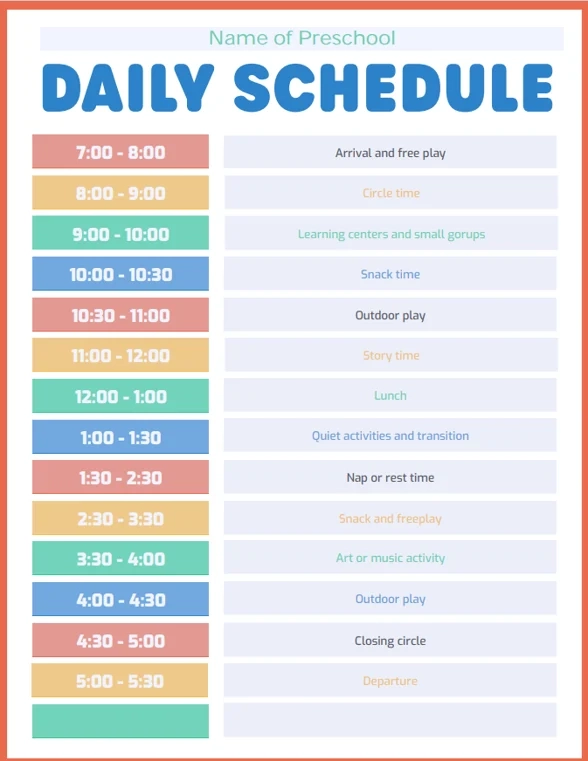
At-Home and Homeschool Preschool Schedules
The Importance of a Preschool Schedule at Home
Creating a preschool schedule at home brings structure to your day and enhances the learning potential in a home environment. Without a fixed preschool schedule, homeschooling families often find their days drifting into disorganization or burnout. Having a consistent routine helps both parents and children stay engaged and motivated.
Sample Homeschool Preschool Daily Routine
Here’s a sample preschool homeschool schedule designed specifically for home settings:
- 8:30 AM – Morning Routine (brush teeth, get dressed, breakfast)
- 9:00 AM – Calendar & Weather Discussion
- 9:30 AM – Letter, Number, or Theme-Based Learning
- 10:00 AM – Snack Time
- 10:15 AM – Arts & Crafts or Fine Motor Activities
- 11:00 AM – Outdoor Play or Nature Walk
- 12:00 PM – Lunch & Story Time
- 12:30 PM – Nap or Quiet Time
- 2:00 PM – Music, Dance, or Hands-on Exploration
- 3:00 PM – Free Play or Baking/Cooking Together
This structure balances learning and play while allowing flexibility based on your child’s needs and energy levels.
Using Visual and Printable Tools for Home Use
Visual aids such as a preschool picture schedule, printable magnet boards, and pictorial charts can make your homeschool preschool schedule more accessible. These tools are especially effective for younger children or visual learners.
Download a preschool visual schedule template free to personalize it with your child’s name, icons, and daily flow. Many parents find that including photos of their child performing the task helps build stronger routine memory. Explore tools here
Adapting for Summer and Seasonal Flexibility
In summer, your preschool schedule at home may need to be more flexible. Include outdoor water play, gardening, and seasonal crafts. A summer schedule for preschoolers at home might look like:
- 8:30 AM – Light Breakfast
- 9:00 AM – Outdoor Water Activity
- 10:00 AM – Nature Exploration or Bug Hunt
- 11:00 AM – Snack & Outdoor Story Time
- 12:00 PM – Picnic Lunch
- 1:00 PM – Nap
- 2:00 PM – Ice Painting, Lemonade Making, or Quiet Play
Homeschool preschool schedules don’t have to be rigid—they just need to be reliable enough to provide emotional security and learning flow.
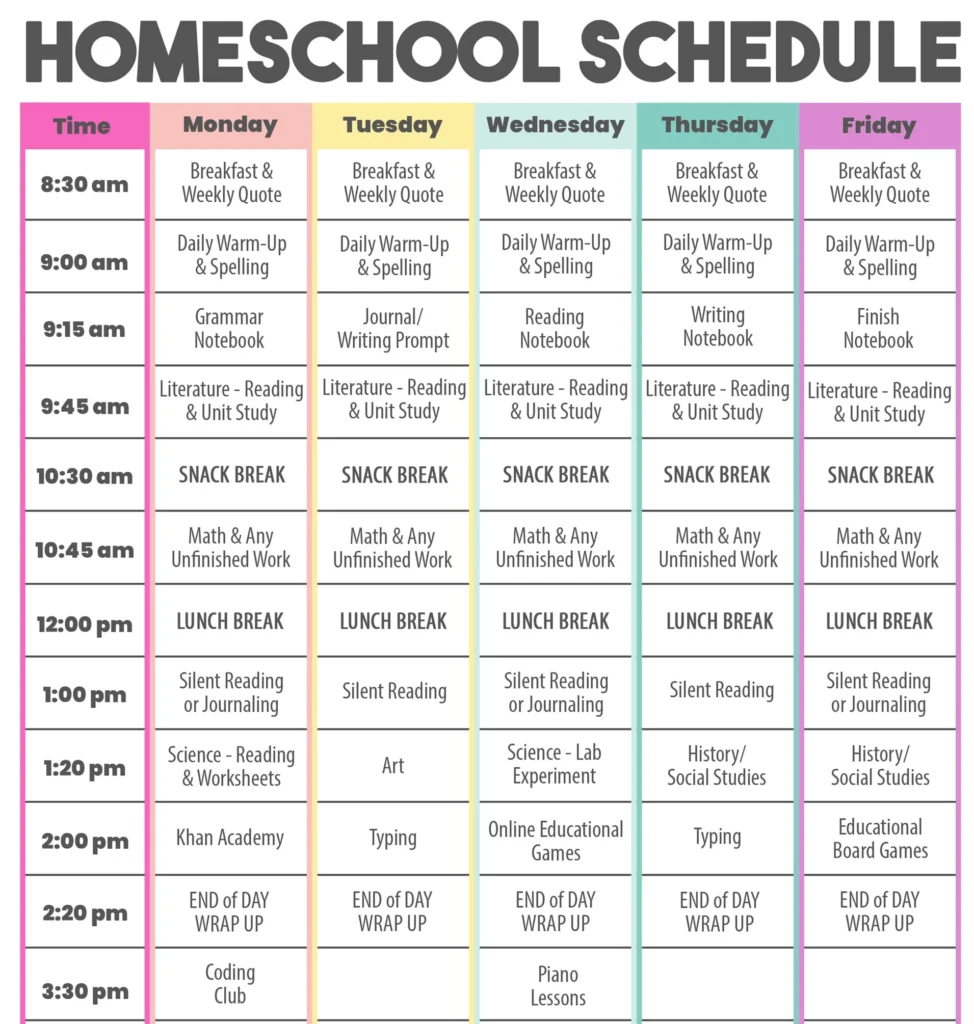
Preschool Visual & Picture Schedules
Why Visual Schedules Work in Preschool Settings
Visual schedules are essential tools for preschoolers because most young children are still developing language and time-telling skills. By using pictures and symbols, we offer a concrete and accessible way for them to understand what’s coming next. This builds autonomy and reduces stress during transitions.
For example, when children see a photo of a snack or circle time on a chart, they immediately understand what’s expected without needing constant verbal reminders. This is especially helpful for neurodiverse learners, including those with autism or ADHD, who benefit from consistent visual cues.
Tools for Creating a Visual Preschool Schedule
You can build a preschool visual schedule using a variety of tools:
- Laminated cards with icons or real photos
- Magnetic boards with movable pieces
- Velcro wall charts
- Pocket charts with time blocks
A preschool schedule chart should include clear visuals for each daily activity: playtime, snack, rest, cleanup, etc. You can use free printable templates online or make your own based on classroom photos. Here’s a free download
How to Introduce Picture Schedules to Preschoolers
Start simple: use 3–5 images to represent key parts of the day. As children adjust, expand to include transitions like cleanup, handwashing, or lining up.
Place your picture schedule preschool chart where children can easily reach and interact with it. Encourage them to move or point to the next activity as part of the routine. This builds both visual comprehension and sequencing skills.
Many educators even use a classroom helper system, assigning children to “schedule duty” so they begin managing their own routines through visuals.
Incorporating a visual schedule for preschoolers takes a little setup but delivers big benefits in independence, self-regulation, and smoother classroom flow.
Real Examples of Preschool Schedules
Example of a Full Day Preschool Schedule
A full-day preschool schedule typically spans 6–8 hours, giving plenty of time for academic, social, and physical development. Below is a real-world inspired example based on successful classrooms:
- 8:30 AM – Arrival & Welcome Activities
- 9:00 AM – Morning Circle & Calendar Time
- 9:30 AM – Learning Centers (Math, Literacy, Sensory)
- 10:30 AM – Snack Time
- 10:45 AM – Outdoor Free Play
- 11:30 AM – Group Project / Art
- 12:00 PM – Lunch
- 12:30 PM – Nap or Quiet Time
- 2:00 PM – Storytelling & Puppet Show
- 2:30 PM – Music & Movement
- 3:00 PM – Themed Learning or Dramatic Play
- 3:30 PM – Snack & Wind Down
- 4:00 PM – Dismissal or Extended Free Play
This sample preschool daily schedule balances structure with flexibility, and allows time for creativity, rest, and gross motor skill development.
Half Day Preschool Schedule Example
Half-day programs usually run 2.5 to 4 hours. They’re great for part-time learning and socialization. Here’s a common half-day layout:
- 8:30 AM – Arrival & Table Time
- 9:00 AM – Circle Time & Songs
- 9:30 AM – Literacy or STEM Center Rotation
- 10:15 AM – Snack Break
- 10:30 AM – Outdoor Exploration or Gym Time
- 11:15 AM – Art or Sensory Activity
- 11:45 AM – Closing Circle & Dismissal
This type of schedule works well for children just starting preschool or for programs that focus on enrichment.
Preschool Class Schedule With Rotations
Classroom schedules in larger preschool settings often include small group rotations. This format helps teachers focus on differentiated instruction.
Example:
- 9:00 AM – Circle Time
- 9:30 AM to 10:30 AM – Three 20-min rotations:
- Station A: Teacher-led Literacy
- Station B: Independent Reading or Puzzles
- Station C: Dramatic Play
- 10:30 AM – Snack & Recess
- 11:15 AM – Science or Theme Project
Using a rotation system in your preschool class schedule allows for both individualized attention and independent learning.
Printable and Visual Schedule Examples
You can bring these ideas to life using downloadable preschool schedule printables, which offer picture icons and editable blocks for customization. Whether you need a preschool visual schedule template free, a classroom wall chart, or a binder insert, there’s a format that fits.
Check out this sample preschool schedule printable bundle with multiple layouts: Download now
Creating Your Own Preschool Schedule
Key Factors to Consider Before You Begin
Before creating your own preschool schedule, think about your teaching environment, children’s ages, and your educational goals. Are you at home with one child, or managing a classroom of twenty? Do you follow Montessori, play-based, or thematic curriculum?
Important considerations:
- Class Size & Age Range: Younger children need more breaks and shorter sessions.
- Learning Objectives: Balance academic goals with social-emotional development.
- Space & Resources: Schedule gross motor activities if you have an outdoor area.
- Transitions: Budget time between activities—this is where most behavioral issues occur.
Also, be mindful of cultural differences and family routines. A typical preschool schedule in North America may differ from one in Australia or Europe.
Steps to Create a Custom Schedule
- List Your Time Blocks – Break the day into 15-30 minute chunks depending on attention span.
- Prioritize Core Activities – Include literacy, numeracy, art, and physical movement.
- Build in Flexibility – Add extra time for snacks, transitions, and emotional needs.
- Use Templates – Start with a printable preschool schedule and tweak it.
- Test & Observe – Implement for a week, then adjust based on behavior and feedback.
Tools That Make It Easier
You don’t need to start from scratch. Use these tools to build your ideal preschool day schedule:
- Daily schedule preschool templates (editable)
- Preschool visual schedules with icons
- Picture schedule preschool sets for wall charts or folders
- Apps or software like Canva, PowerPoint, or Google Slides for printable charts
Preschool schedule planning isn’t about perfection—it’s about predictability, balance, and flow. If your first version doesn’t work perfectly, don’t worry. The best sample preschool schedule is the one that keeps evolving to meet your children’s needs.
Coming up: fun and flexible summer schedule ideas for preschoolers!
Preschool Summer Schedule Ideas
Why Summer Schedules Need Flexibility
Summer is a perfect time to relax some structure—but not all of it. A flexible preschool summer schedule helps maintain a child’s sense of routine while embracing seasonal activities like water play, gardening, and nature exploration.
Too much unstructured time can lead to boredom or behavioral issues, while too much structure can feel stifling. The best preschool summer schedule includes a loose flow with predictable anchors: morning routines, lunch, nap, and bedtime. Everything else can shift around outdoor conditions and child interest.
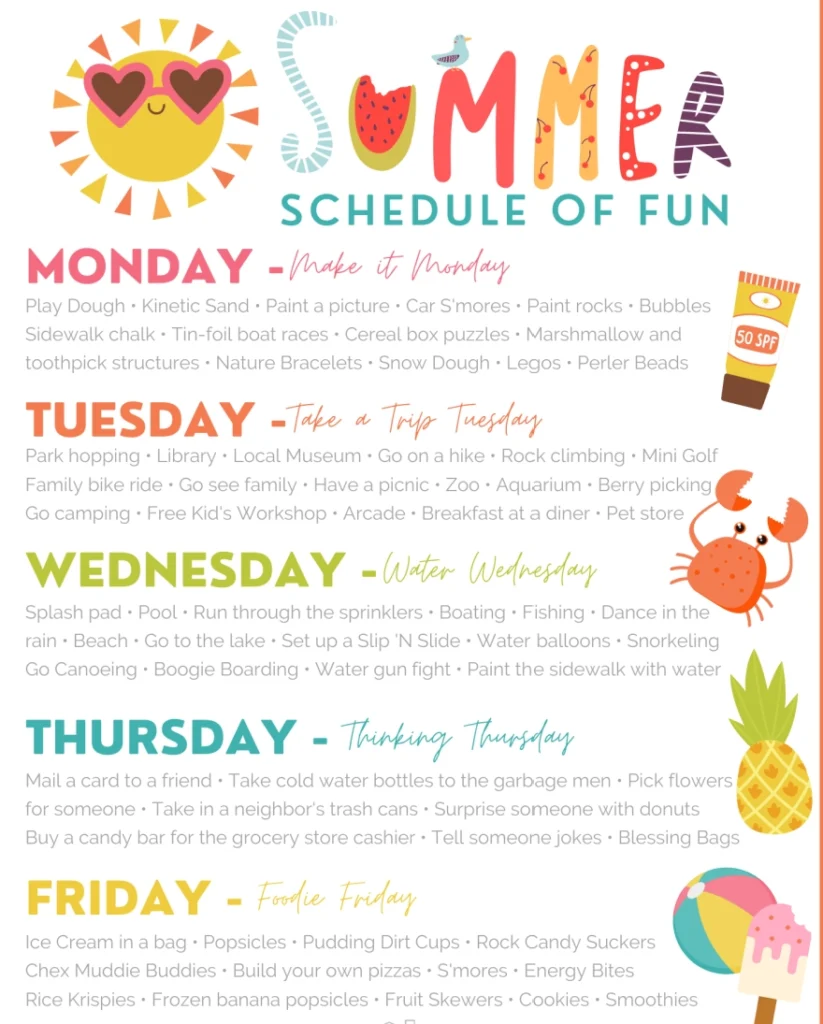
Sample Summer Preschool Schedule (At Home or School)
Here’s a sample daily preschool summer schedule that balances fun, learning, and rest:
- 8:30 AM – Breakfast & Morning Stretch
- 9:00 AM – Outdoor Water Play / Nature Walk
- 10:00 AM – Snack & Summer Story Circle
- 10:30 AM – Art with Natural Materials (leaves, shells, chalk)
- 11:15 AM – Sensory Bins or Free Play
- 12:00 PM – Picnic Lunch
- 12:30 PM – Rest / Nap / Quiet Time
- 2:00 PM – Indoor Games or Cooking Activity
- 3:00 PM – Music & Dancing or Science Fun (ice melting, sink/float)
This summer schedule for preschoolers at home or in class can be customized daily. You might also consider weekly themes like “Ocean Week” or “Backyard Camping Week.”
Tips for Keeping Summer Schedules Engaging
- Use visual summer schedule printables to keep kids on track
- Plan for water days, library trips, and family days
- Let kids help plan their day with pictorial schedule cards
- Include time for rest, reflection, and unstructured creativity
Remember, a good summer preschool schedule doesn’t eliminate fun—it organizes it in a way that supports child-led learning and positive behavior. Whether you’re home with one child or managing a summer preschool group, flexible structure is your best friend.
Next: More related content and resources to support your preschool planning journey.
Conclusion
At XIHA Furniture, we believe that a strong preschool schedule builds more than just structure—it builds confidence, independence, and joyful learning. From classroom to homeschool, from full day to summer fun, the right schedule supports both children and educators in making the most of every moment.
With our commitment to quality, affordability, and educational insight, we’re here to help you create the perfect environment to match your schedule—furnished to inspire and designed to grow with your preschoolers.
Start simple. Test often. And don’t forget: the best schedule is the one that grows with your preschooler. A strong preschool schedule builds more than just structure—it builds confidence, independence, and joyful learning. From classroom to homeschool, from full day to summer fun, the right schedule supports both children and educators in making the most of every moment.

